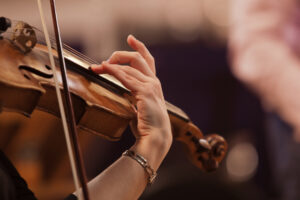 Our Lessons in Your Home violin teachers combat these 5 problems in their lessons frequently. All of these habits contribute to poor sound quality and possibly even tension and pain, so it is important for young violinists to be vigilant about avoiding these errors. Check out our DC violin lessons to learn more and receive specialized one-on-one attention to correct these and other violin playing issues.
Our Lessons in Your Home violin teachers combat these 5 problems in their lessons frequently. All of these habits contribute to poor sound quality and possibly even tension and pain, so it is important for young violinists to be vigilant about avoiding these errors. Check out our DC violin lessons to learn more and receive specialized one-on-one attention to correct these and other violin playing issues.
Bent Left Wrist
Perhaps the most common problem with beginner violinists is having a bent left wrist. This is the issue students are reprimanded about most from private violin instructors in DC and orchestra teachers. When I was young, our teacher had the violinists imagine there was a tomato between your left palm and the neck of the violin and if your wrist bent so that your palm touched the neck, you squashed the tomato. Other teachers compare this bad habit of bending your wrist back to a waiter holding up a tray. Instead, think about keeping a mostly straight line from your elbow up to your knuckles. The reason we find it tempting to bend our wrist back is because it can be easier to hold the violin up that way if something else in the posture isn’t correct. Be sure that the violin is being held correctly with the shoulder, jaw, and arm in order to avoid holding the violin with the palm. In relation to this, there are some exercises to improve violin play.
Not Having A Curved Right Thumb On The Bow
In all string players, but especially violin, our right thumb can be a source of tension. While we are all taught to have a relaxed thumb, it can be a difficult thing to monitor because it is hidden by the rest of the hand. When a violinist is playing a difficult or very loud passage, it can be tempting to squeeze the thumb so that it is either straight or hyperextended. This squeezing causes the muscles in your palm to carry a lot of tension, which not only causes poor tone quality but also can lead to injury if left unaddressed.
Not Rotating Your Left Elbow To Reach Different Strings and Positions
Generally, when playing violin we don’t ever want to be too rigid or still with any part of our body. An important example of this is keeping our left elbow in one place no matter where the hand is on the violin. Instead, the elbow should be engaged in moving from the E string down to the G string and back or during shifting between positions. Once again, this minimizes tension by ensuring the best possible hand position on any note. To correct this, feel the left elbow come forward for lower strings and backward slightly for higher strings.
Not Utilizing The Whole Bow
One of my former teachers told me “You’ve paid for the whole bow, so use all of it!” Violinists frequently forget to use every inch of the bow hair when it’s appropriate. Often times when I tell my students to use the whole boy, they still miss the last several inches on either end. This can be a habit formed from when we are very young and our teachers just want us playing the correct note at the correct time and don’t prioritize bow use. Additionally, a lot of beginner playing requires short bows, so we don’t learn how to move our arm to use the entire bow until much later. To correct this, play open strings or scales with the entire bow by opening the upper arm and opening from the elbow.
Crooked Bow Stroke
One of the hardest things to fix for string players is a crooked bow. From our perspective looking at the bridge, it probably seems like we are playing with a straight bow. Without a bow that remains perpendicular to the bridge, we cannot control our contact point on the string and cannot create the best tone possible. While your teacher can watch you and adjust as necessary, you can also play in front of a mirror to ensure the bow isn’t skating up and down the string. Also, you can play exercises in which you watch the bow’s contact point and try to keep the bow in that same place. If the bow moves up or down, adjust accordingly. Listen for the sound you can get out of your violin when the bow is straight and try to recreate it as often as possible!
Lessons in Your Home violin teachers are well-acquainted with these and other bad violin habits and can give you the guidance you need to make steady improvement. Contact us to find a teacher that best matches your musical goals. Our teachers will come right to your home for every lesson, plus we offer virtual music lessons, too. Our online music lessons are taught by local music teachers who plan their lessons to suit your child.
